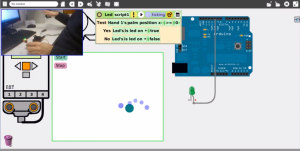It is a reality that, much more than before, we are immersed in the era of interaction and new generations demand efficient feedback. Kids come to our world as scientists because they adopt easily the culture of “what if I do X?”. They want to know, they want to experiment to see what happens, they repeat procedures whose results grab their attention, especially the ones that makes them laugh. And by doing these actions, they begin to create their own ideas about the world that surrounds them with the help of their hands. During kindergarten, kids build their representations of the world with putty, adapt designs, throw things and destroy them if they find it necessary.
At some point, this changes. Kids learn to read and receive books which are fantastic because they teach us useful knowledge and keep the class organized. Both teachers and students know what to do and have a normalized flow of homework in order to foster abstract thinking over years. However, experimental approaches to gain knowledge from kinesthetic ways begin to decrease.
I always liked the idea of giving importance to kinesthetic learning as a complement. It’s very hard to find someone who has forgotten biking, or who writes without looking at the keyboard, plays the piano or hits a tennis ball without looking a racket. All of These examples have at least one thing in common that books do not have: instant feedback during interaction. Computers are perfect tools for obtaining instant feedback during creational processes. However, the reality shows that we are still conditioned by outdated paradigms and we put ourselves as consumers and our way of learning with them seems more like receiving knowledge during a short attention span instead of using it (except for videogames).
I think that educational robotics is something that combines science with kinesthetic development, experimentation and interaction with real-world feedback. Moreover, kids are very keen on robots. Man-machine interfaces have evolved and Leap Motion sensor is an example. It provides an untraditional way to interact with the computer using your hands and it goes in line with our vision of learning. Furthermore, it gives us an abstract representation of hands’ data which we consider very useful to have it in our platform. This will provide another way to interact with different robotic kits enriching the expression within the programming environment open-source Physical Etoys.
We invite you to download our LeapMotion.pem for Physical Etoys (Windows 7 or later) here.
Thank you, Leap Inc. for giving us such a wonderful device 🙂
Mucho más que antes, nos encontramos inmersos en la era de la interacción y las nuevas generaciones demandan feedback eficiente. Los nenes vienen a nuestro mundo como científicos porque adoptan fácilmente la cultura del “Qué pasaría si hago X?”. Ellos quieren saber, quieren experimentar para ver qué pasa, repiten procedimientos cuyos resultados les llama la atención, especialmente los que los hacen reír. Y con estas acciones ellos comienzan a crear sus propias ideas acerca del mundo que los rodea con la ayuda de sus manos. Durante el jardín de infantes, los niños realizan sus propias representaciones del mundo con plastilina, adaptan los diseños, tiran cosas y las destruyen si lo creen necesario.
En algún punto, esto cambia. Los nenes aprenden a leer y reciben libros, que son fantásticos porque nos enseñan conocimiento útil y mantienen la clase organizada. Tanto maestros como estudiantes saben lo que tienen que hacer y se les asigna un flujo normalizado de tareas para el hogar para incentivar el pensamiento abstracto a medida que pasan los años. Sin embargo, las aproximaciones empíricas para obtener conocimiento en forma kinestésica se decrementan.
Yo creo que la robótica educativa es algo que combina ciencia con el desarrollo kinestésico, experimentación e interacción con feedback del mundo real. Además, los niños, manifiestan mucho interés por los robots. Las interfaces hombre/máquina evolucionaron y el sensor Leap Motion es prueba de ello. Provee una forma no tradicional de interactuar con las computadoras usando las manos y va en consonancia con nuestra visión del aprendizaje. Aparte, nos da una representación abstracta de los datos de las manos que nos parece de suma importancia para agregarlo a nuestra plataforma. Esto proveerá otra forma de interacción con kits de robótica, enriqueciendo la expresividad dentro del ambiente de programación open-source Physical Etoys.
Los invitamos a bajarse nuestro LeapMotion.pem para Physical Etoys (Windows 7 en adelante) here.
Muchas gracias Leap Inc. por darnos un dispositivo maravilloso.


